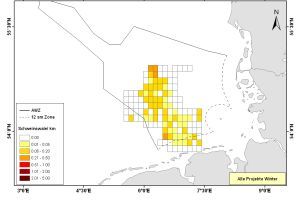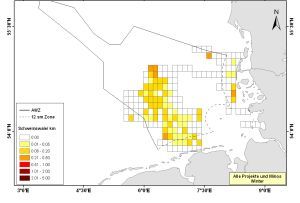
| Project data | |
|---|---|
| Project leader: | Prof. Dr. Ursula Siebert |
| Scientific staff: | Michael Dähne, Verena Peschko, Hauke Giewat, Andreas Ruser, Sacha Viquerat |
| Sponsor: | Federal Ministry for the Environment, Nature Conservation and Nuclear Safety (BMU) |
| Project executing organisation: | Projektträger Jülich Geschäftsbereich Erneuerbare Energien |
| Project coordination: | Federal Maritime and Hydrographic Agency, (BSH) Hamburg |
| F+E Contractor: | ITAW |
Project description
Within Environmental Impact Assessments (EIAs) of offshore wind farms, intensive studies in and around the planning area of potential sites are being conducted. These studies partially continue after licensing that is granted within a monitoring covering the building and operating phase. All data of EIAs of the last and future years shall be collected and merged into one database to allow for direct comparison of their results, get a better overview about marine mammal occurrence as well as to further standardise future EIAs. Furthermore, data of long term and large scale projects like MINOS will be integrated into this database.
State of the art survey methods for marine mammals are aerial as well as ship board visual surveys as well as investigations with acoustic data loggers to register the echolocation activity of harbour porpoises. A database has already been created for aerial surveys using standard “line transect distance sampling” methodology exclusively for harbour porpoises at a altitude of 183 m. So far results of some EIAs were integrated. The EIAs show similar results when compared to the MINOS dataset. Especially for winter surveys the EIAs complement the MINOS-dataset, thus allowing for a better evaluation of harbour porpoise distribution in the German North Sea (Fig 1).


Fig 1: Winter distribution of harbour porpoise in the German Bight (Sightings/ km transect line), left: only EIA data, right: Data of EIAs and MINOS
In the next steps data of combined surveys (for seabirds as well as harbour porpoises, flight altitude 76 m), ship surveys and acoustic monitoring will be transferred to the database. In particular for data from the acoustic monitoring, standards need to be defined regarding used software and processing algorithms to ensure the comparability of future studies with already acquired datasets. Requirements are being developed at the moment to assure that data from EIAs, monitoring schemes and research projects will be thoroughly checked for their quality before imported to the joint database.


